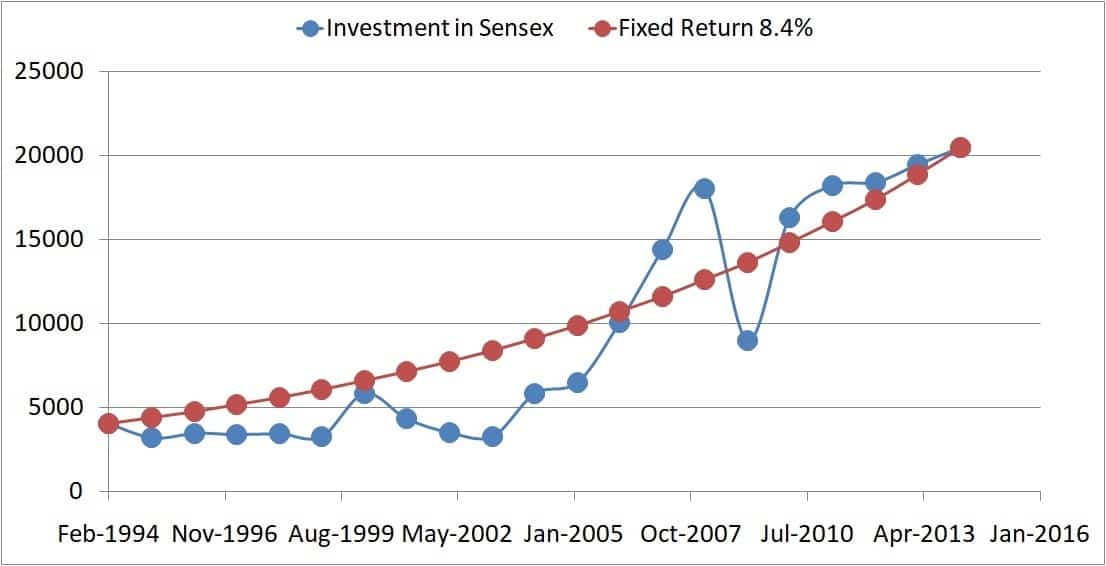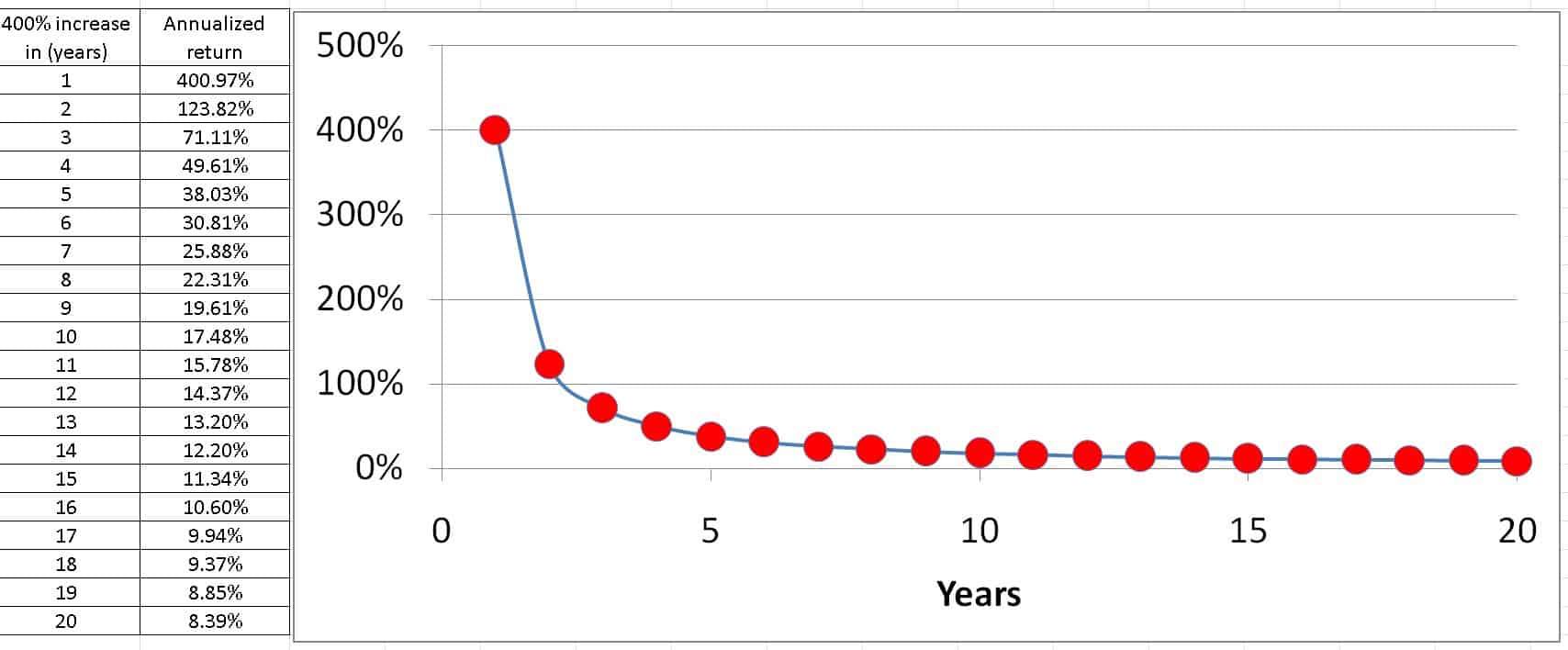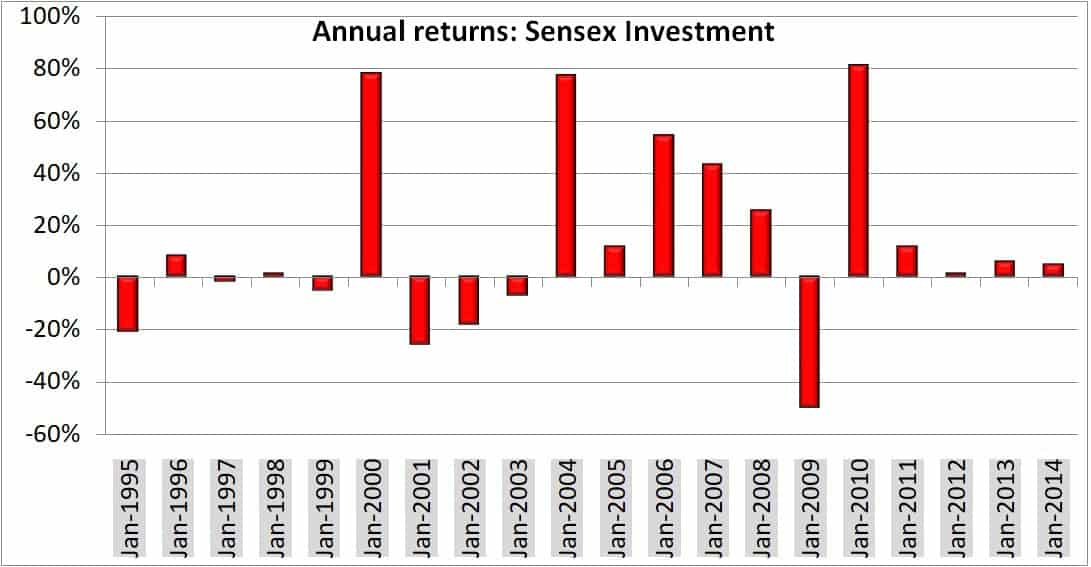Last Updated on December 28, 2021 at 6:31 pm
Although many equity investors like to think that they are saner than crypto-investors, the truth is that there is not much difference in their investment “strategies” (if we can call it that). I am referring to “Hodl to the moon” which for equity investors roughly translates as “don’t sell in fear, equity will be profitable over the long term”. This is not a post about cryptocurrencies, in the sense that I will not be referring to them directly. This is a post about “holding risk” and about how time plays a crucial role in determining how profitable we are.
This post is the second part to Should I expect lower returns from equity in future? and is based on a trivia mentioned in Sensex Charts 35 year returns analysis: stock market returns vs risk distribution:
A man buys one unit of Sensex (let us assume index investing was possible then) just days before the Harshad Mehta scam broke on 30th March 1992 with the index at 4091.43 (arrows below). Over the next 25 years, he kept his unshakable faith in Equity and held on to his investment, no matter what. Finally, on 24th March 2017 with the index at 29421.40 (619% increase), he checks the annualized return he has got. What would be the result of this calculation? This is before dividends. A 1.5% to 2% can be added to the return due to dividends.
I wrote this last month when Equity LTCG was still tax-free! Now with the 10% tax (which despite our best gymnastics is unavoidable – unless you want to stay poor ), the effect of the dividend mentioned above is cancelled at least by half. See: Equity LTCG Taxation: How much tax do I need to pay?
This example is one of 354 instances when a 20Y Sensex return computed between April 1979 and Jan 2018 resulted in 10% or lesser returns. Amusingly all those instances are between Feb 1992 and June 1996. Now, if I were a mutual fund sales guy, I would happily claim that is a “one-off” and “unlikely to recur”. Unfortunately, as I am only an investor, I must consider possibilities and not probabilities. I would rather focus on “preparing for the worst” than ignore warnings from the past.
Join 32,000+ readers and get free money management solutions delivered to your inbox! Subscribe to get posts via email! (Link takes you to our email sign-up form)
🔥Want to create a complete financial plan? Learn goal-based investing? Exclusive access to our DIY tools? Increase your income with your skills? Use this link to enjoy massive discounts on our robo-advisory tool & courses! 🔥
Yes, this is a clear case of cherry-picking. However, I am not picking good cherries. I am worried about the rotten ones. You get life insurance and health insurance because you want to protect against the possibility of life offering your family rotten cherries. The logic is identical here.
Equity investing (or crypto trading) requires continuous risk management and a proper exit strategy. The first step is to recognise, that things will not magically turn out okay in the end.
Before we consider, let us consider the situation mentioned in the title. The Sensex closed on 4084 on Feb 22, 1994, and was 20464 on Feb 17, 2014. Again, if you look at only that information, it seems awesome – a 400% increase ( 5 times). However, the annualized return is only 8% (excluding dividends, but even if you include them, the central message will not change).
Yes, money was made: 4000 to 20,000 is hardly small. However, during the first 7 years of the investment journey, most fixed income rates were pretty high (Because India was recovering from the verge of bankruptcy) – 11-12%(!). Then for almost the entire remaining journey, the fixed income rates were 8%-ish.
Now consider the emotional state of the equity investor in the above time period: The markets had just crashed due to the Harshad Mehta scam, for the entires 90s, the market went nowhere. Then came the 2000- crash, the big bull-run, the 2008-crash, recovery, sideways market and then hope…
Then 8% annualized return on the equity investment is no way proportional to the risk taken by the investor. Now, let us please not start thinking – she could have invested in other stocks, he could have done a SIP (assuming it existed then), she could have invested in mutual funds blah blah.
Excuse me, that is just the denial kicking in. If you think, using SIPs, using mutual funds, investing in “good stocks” (as if we will know when we invest) etc. can prevent us from getting low rewards, then all I can say is good luck. Maybe only good things will happen to optimists.
With all that out of the way, let us ask, why is the annualized return so low when the absolute return or gain or profit is so high?!
The answer is time! Well, that has two meanings – a mathematical one and a philosophical one as in “bad time”!
The blue dots represent annual Sensex values. This after 20Y has a cagr of 8.4% (annualized return). If we assume each year gave you 8.4% return, you will get the red dots. So you can see how the idea of annualized return pushes all the ups and downs into the carpet.
You can see the effect of “bad time” here. For the first 9 years, the returns were flat. Then the market zoomed, and then it crashed and then it recovered, but not too much (as of 2014). So after 20Y of patient holding (if that is not hodling to the moon, I don’t know what is), the return is only 8.4%.
Now let us look at it in terms of actual time “lost”
If Rs. 1 became ~ Rs. 5 in one year, the absolute return = annualized return = 400%.
If Rs. 1 became ~ Rs. 5 in two years, the absolute return is the same but the annualized return is 123.8%.
Now see how the annualized return drops as it takes more and more time to achieve the same growth.
This is hodling to the moon risk, or time risk. For high returns, good growth is essential, but that good growth should also occur reasonably fast!
The same applies to crypto too. Bitcoin may recover and move up. What matters is how soon it does that. The statement “Bitcoin is the future” conveniently ignores the risk of hodling to the moon. Never forget that Bitcoin has seen big periods of flat markets. So its nothing new!
This effect is also known as sequence of returns risk.
These are the annual returns after each year of investment.
So let us combine the returns:
(1-20.85%) x(1+8.26%) x (1-1.74%) x (1+1.13%) x (1-5.02%) x (1+77.88%) x (1 -25.82%) x (1 -18.38%) x (1 – 7.17%) x (1+ 77.12%) x (1+11.69%) x (1+54.24%) x (1+42.90%) x (1+25.5%) x (1 – 50.13%) x (1+81.11%) x (1+ 11.54%) x (1+ 1.19%) x (1+ 5.82%) x (1 +4.94%)
This gives 5.009. That is Rs. 1 invested and held on for those 20Y would have resulted in Rs. 5.009.
To find the CAGR, we write
1 x (1+ CAGR)^20 =5.009
Which gives CAGR = 8.4%.
^ here means (1+CAGR) is multiplied 20 times (i.e. to the power of 20).
So, what is the point?
When it comes to market-linked instruments, hope that things will work out in the long-term is as bad as over-confidence past on recent high returns.
ABC: Always Be Closing* (out risk):
- Have the right asset allocation at the right time.
- Reset the asset allocation at least once a year initially and then 2/3 times a year later on. So now you need to pay some tax. So what?! Risk reduction is more important.
- Keep an eye on how much money you need for the goal every year and make sure most of it is ready in safe assets. This is why goal based investing is a simple but effective strategy to manage market risk. It gives you purpose.
- If you can pull it off, learn to tactically change asset allocation as per market conditions to reduce risk. This does not mean higher return. Just better sleep. See: Is it possible to time the market?
- Lower expectations mean lesser mistakes, lesser management and again better sleep.
* After the movie Glengarry Glen Ross.
Simple Steps to De-risk Your Investment Portfolio

Use our Robo-advisory Tool to create a complete financial plan! ⇐More than 3,000 investors and advisors use this! Use the discount code: robo25 for a 20% discount. Plan your retirement (early, normal, before, and after), as well as non-recurring financial goals (such as child education) and recurring financial goals (like holidays and appliance purchases). The tool would help anyone aged 18 to 80 plan for their retirement, as well as six other non-recurring financial goals and four recurring financial goals, with a detailed cash flow summary.
🔥You can also avail massive discounts on our courses and the freefincal investor circle! 🔥& join our community of 8000+ users!
Track your mutual funds and stock investments with this Google Sheet!
We also publish monthly equity mutual funds, debt and hybrid mutual funds, index funds, and ETF screeners, as well as momentum and low-volatility stock screeners.
You can follow our articles on Google News

We have over 1,000 videos on YouTube!

Join our WhatsApp Channel



- Do you have a comment about the above article? Reach out to us on Twitter: @freefincal or @pattufreefincal
- Have a question? Subscribe to our newsletter using the form below.
- Hit 'reply' to any email from us! We do not offer personalised investment advice. We can write a detailed article without mentioning your name if you have a generic question.
Join 32,000+ readers and get free money management solutions delivered to your inbox! Subscribe to get posts via email! (Link takes you to our email sign-up form)
About The Author
 Dr M. Pattabiraman (PhD) is the founder, managing editor and primary author of freefincal. He is an associate professor at the Indian Institute of Technology, Madras. He has over 13 years of experience publishing news analysis, research and financial product development. Connect with him via Twitter(X), LinkedIn, or YouTube. Pattabiraman has co-authored three print books: (1) You can be rich too with goal-based investing (CNBC TV18) for DIY investors. (2) Gamechanger for young earners. (3) Chinchu Gets a Superpower! for kids. He has also written seven other free e-books on various money management topics. He is a patron and co-founder of “Fee-only India,” an organisation promoting unbiased, commission-free, AUM-independent investment advice.
Dr M. Pattabiraman (PhD) is the founder, managing editor and primary author of freefincal. He is an associate professor at the Indian Institute of Technology, Madras. He has over 13 years of experience publishing news analysis, research and financial product development. Connect with him via Twitter(X), LinkedIn, or YouTube. Pattabiraman has co-authored three print books: (1) You can be rich too with goal-based investing (CNBC TV18) for DIY investors. (2) Gamechanger for young earners. (3) Chinchu Gets a Superpower! for kids. He has also written seven other free e-books on various money management topics. He is a patron and co-founder of “Fee-only India,” an organisation promoting unbiased, commission-free, AUM-independent investment advice.Our flagship course! Learn to manage your portfolio like a pro to achieve your goals regardless of market conditions! ⇐ More than 3,500 investors and advisors are part of our exclusive community! Get clarity on how to plan for your goals and achieve the necessary corpus no matter the market condition!! Watch the first lecture for free! One-time payment! No recurring fees! Life-long access to videos! Reduce fear, uncertainty and doubt while investing! Learn how to plan for your goals before and after retirement with confidence.
Increase your income by getting people to pay for your skills! ⇐ More than 800 salaried employees, entrepreneurs and financial advisors are part of our exclusive community! Learn how to get people to pay for your skills! Whether you are a professional or small business owner seeking more clients through online visibility, or a salaried individual looking for a side income or passive income, we will show you how to achieve this by showcasing your skills and building a community that trusts and pays you. (watch 1st lecture for free). One-time payment! No recurring fees! Life-long access to videos!
Our book for kids: “Chinchu Gets a Superpower!” is now available!


Must-read book even for adults! This is something that every parent should teach their kids right from their young age. The importance of money management and decision making based on their wants and needs. Very nicely written in simple terms. - Arun.Buy the book: Chinchu gets a superpower for your child!
How to profit from content writing: Our new ebook is for those interested in getting a side income via content writing. It is available at a 50% discount for Rs. 500 only!
Do you want to check if the market is overvalued or undervalued? Use our market valuation tool (it will work with any index!), or get the Tactical Buy/Sell timing tool!
We publish monthly mutual fund screeners and momentum, low-volatility stock screeners.
About freefincal & its content policy. Freefincal is a News Media organisation dedicated to providing original analysis, reports, reviews and insights on mutual funds, stocks, investing, retirement and personal finance developments. We do so without conflict of interest and bias. Follow us on Google News. Freefincal serves more than three million readers a year (5 million page views) with articles based only on factual information and detailed analysis by its authors. All statements made will be verified with credible and knowledgeable sources before publication. Freefincal does not publish paid articles, promotions, PR, satire or opinions without data. All opinions will be inferences backed by verifiable, reproducible evidence/data. Contact Information: To get in touch, please use our contact form. (Sponsored posts or paid collaborations will not be entertained.)
Connect with us on social media
- Twitter @freefincal
- Subscribe to our YouTube Videos
- Posts feed via Feedburner.
Our publications
You Can Be Rich Too with Goal-Based Investing
 Published by CNBC TV18, this book is designed to help you ask the right questions and find the correct answers. Additionally, it comes with nine online calculators, allowing you to create custom solutions tailored to your lifestyle. Get it now.
Published by CNBC TV18, this book is designed to help you ask the right questions and find the correct answers. Additionally, it comes with nine online calculators, allowing you to create custom solutions tailored to your lifestyle. Get it now.Gamechanger: Forget Startups, Join Corporate & Still Live the Rich Life You Want
 This book is designed for young earners to get their basics right from the start! It will also help you travel to exotic places at a low cost! Get it or gift it to a young earner.
This book is designed for young earners to get their basics right from the start! It will also help you travel to exotic places at a low cost! Get it or gift it to a young earner.Your Ultimate Guide to Travel
 This is an in-depth exploration of vacation planning, including finding affordable flights, budget accommodations, and practical travel tips. It also examines the benefits of travelling slowly, both financially and psychologically, with links to relevant web pages and guidance at every step. Get the PDF for Rs 300 (instant download)
This is an in-depth exploration of vacation planning, including finding affordable flights, budget accommodations, and practical travel tips. It also examines the benefits of travelling slowly, both financially and psychologically, with links to relevant web pages and guidance at every step. Get the PDF for Rs 300 (instant download)

